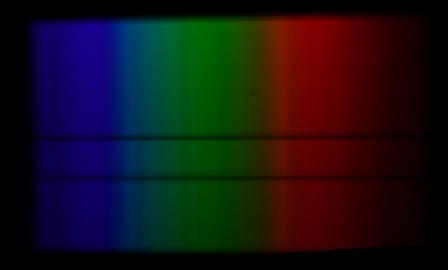Forum Replies Created
-
AuthorPosts
-
 David PerkinParticipant
David PerkinParticipantAs Robin said, we continued the discussion by EMail.
I would like to thank Robin publicly for his help and advice.
Regards,
David Perkin.
 David PerkinParticipant
David PerkinParticipantThe forum posting system is getting a bit tedious. What happened that time?

 David PerkinParticipant
David PerkinParticipantDear Robin,
This is a second go – the previous attempt just vanished when I tried to add an attachment.
Yes, I’m local. We’ve met at the Cockermouth Astronomical Society.
The grism holder now has a screw thread (not a good one IMHO) and so I guess has the tube it fits in. There is no locking screw (very much a retrograde move). The holder seems to come loose easily. It was loose just now when I checked it and I’m sure it was tight when I put it away.
I attach a copy of my last solar spectrum. I seem to not be focused very well (but the loss of detail caused by the size limit on image uploads to the forum has reduced the precision a lot as well).
Regards,
David Perkin.
 David PerkinParticipant
David PerkinParticipantThanks, Robin.
Yes, it’s certainly the grism mounting (mine is slightly different from your description, BTW). I have three Allen keys provided but have so far only used the thinnest – I’m wondering what they are for. It is possible that the thread of the grism holder is vulnerable to cross-threading (I had trouble resetting it: I won’t be touching it again in a hurry).
I did the best I could to put it right and have taken another solar spectrum off the Cumbrian clouds. I found it much harder to get a decent focus this time, though. I’m not sure why that is. Perhaps the grism isn’t quite flat now?
Thanks for the help. As a first real project, I intend to compare the spectrum of Vega as found by my ersatz 100 l/mm filter ring setup and as found by the ALPY.
Regards,
David
 David PerkinParticipant
David PerkinParticipantSeveral people using the Deep Sky Stacker software report success in stacking frames taken using Alt-Az mounts. I would guess that other stackers which, like DSS, use triangles of stars would also work. The triangle-based stackers can accomodate frame rotation. DSS requires star trails to be short so you still need short exposures. Stackers intended for planetary work, such as Registax6 and Autostakkert!2 would probably not work well (although Registax6, I believe, also uses triangles) and those based on fourier transforms could not handle the frame rotation.
Regards,
David Perkin.
 David PerkinParticipant
David PerkinParticipantNew LED lights were installed a few months ago here, replacing an eclectic mixture of sodium and incandescents of various ages.
I can’t make an informed judgement of the effect since there have been so few clear, dark nights this summer and autumn. However, my current impression is that a certain reddish tint to the night sky has gone but overall, the effect may be negative since the Milky Way has not been the impressive sight it was sometimes last year.
The downside for me personally is that the new light fittings have four “bulbs” and are wider than the old ones, leading the new light near our house to shine further into the back garden than its predecessor – it shines directly towards my observatory, carefully sited in the (previous) darkest part of the garden. SO I am very interested in what markjones and petabosley said about baffles. Any advice in how to request them from the Local Authority and on whether there is any prescriptive right to have them installed would be gratefully received.
Regards,
David Perkin
 David PerkinParticipant
David PerkinParticipantMartin and Nick:
I still find the “no upcoming broadcasts” statement worrying: “Next broadcast in April” is actually shorter. The BBC has a record of messing about with schedules of programmes before dropping them.
SGL is aimed at a wider audience than TSAN. I would be unhappy if the keener focus of The Sky at Night were lost even if an intermittent outreach-type programme became established.
Regards,
David Perkin
 David PerkinParticipant
David PerkinParticipantDear Graham,
Sorry about the mistake. I have corrected it.
Regards,
David Perkin.
 David PerkinParticipant
David PerkinParticipantThanks, Martin and Graham, for useful and interesting advice.
I have been trying to photograph the night sky (with film SLR and a homemade webcam setup) for several years, with varying success. I have already got a copy of “An Introduction to DSLR Photography”, which is where I got my original interest in the Canon EOS1000D: the example pictures looked good value for money. I was unaware that the internal IR filters were so strong at the Balmar Alpha (H alpha) line – surely it’s in the visible part of the spectrum. I will certainly get an appropriate T-adaptor.
I think I have a much better sky at this location than previously so it is worth my while setting up to expose for as long as practicable for diffuse objects, to reduce the effect of readout noise, but 30s to 2 minutes should be good enough to start with.
I do wish to attach the camera to my GEM mount either on its own or piggybacked on the telescope – the specialist Camera GEMs seem to be over the top in terms of expense. If I get a new mount for a new telescope, then the existing mount may become dedicated to the camera – if I can find a way of attaching it, that is. There doesn’t seem to be a suitable mounting ring with a camera screw for my tube.
Thanks again,
David Perkin.
-
AuthorPosts
